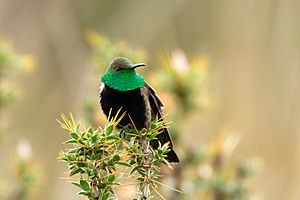Black-breasted hillstar facts for kids
Quick facts for kids Black-breasted hillstar |
|
|---|---|
 |
|
| O. melanogaster observed in Peru | |
| Conservation status | |
| Scientific classification | |
| Genus: |
Oreotrochilus
|
| Species: |
melanogaster
|
 |
|
| Distribution in Peru (green) | |
The black-breasted hillstar (Oreotrochilus melanogaster) is a special type of hummingbird found only in Peru. It's known for its unique black chest. This bird belongs to a group of hummingbirds called "coquettes."
Contents
About the Black-Breasted Hillstar
The black-breasted hillstar is a unique bird because it's the only species in its group, meaning there are no other very close relatives that are also called "black-breasted hillstars."
What Does the Black-Breasted Hillstar Look Like?
This hummingbird is about 13 to 14 cm (5.1 to 5.5 in) long, which is about the length of a pen. It weighs around 8.4 g (0.30 oz), which is lighter than a single coin!
- Males: They have shiny bronzy-brown feathers on their backs. Their throat area, called a gorget, is a bright emerald green. Their sides are grayish-brown, and their chest, belly, and bottom are completely black. Their tail is slightly forked and looks blue-black.
- Females: They are duller, with bronzy-brown feathers all over. Their throat is pale with tiny dark spots. Their tail is greenish-black, and the tips of the outer feathers are white.
Where Do Black-Breasted Hillstars Live?
The black-breasted hillstar lives in the central Andes mountains of Peru. You can mostly find them in the areas called Junín and Huancavelica. They also live in parts of Ancash, Lima, Pasco, and Ayacucho.
These birds like to live in high-altitude puna grasslands. These grasslands often have many Chuquiraga spinosa plants and special cushion cacti. They also like rocky areas. Sometimes, you can even spot them in gardens or near tall Puya raimondii plants. They live at elevations between 3,500 and 4,400 metres (11,500 and 14,400 ft) high in the mountains.
How Do Black-Breasted Hillstars Behave?
Moving Around
Black-breasted hillstars usually stay in the same area all year in Junín. However, in Huancavelica, they might move away from the puna grasslands when the cacti stop flowering.
What Do They Eat?
These hummingbirds mainly drink nectar from flowers. In Junín, they especially like the Chuquiraga spinosa plant. In Huancavelica, they prefer cactus flowers. They also visit other flowering plants, especially red ones, by flying a regular route between them. They might even feed from Eucalyptus trees. Besides nectar, they also catch insects while flying.
How Do They Raise Their Young?
Black-breasted hillstars build their nests in February and March. They make a large cup-shaped nest and glue it to a vertical surface, like a sheltered rock face. Sometimes, they even build nests under the roofs of buildings! A female usually lays two white eggs. We don't know much more about how they raise their chicks.
What Sounds Do They Make?
We don't know a lot about the sounds black-breasted hillstars make. But when they are chasing each other, they make a "fast squeaky twittering" sound that goes up and down.
Is the Black-Breasted Hillstar Safe?
The IUCN (International Union for Conservation of Nature) says the black-breasted hillstar is a species of "Least Concern." This means they are not currently in danger of disappearing. Even though we don't know exactly how many there are, their numbers seem to be steady. These birds are quite common in their habitat, and the puna grasslands where they live are not facing major threats right now.
See also
 In Spanish: Colibrí pechinegro para niños
In Spanish: Colibrí pechinegro para niños



